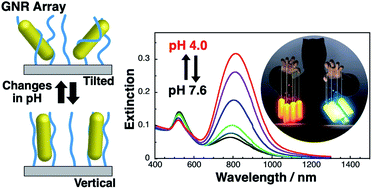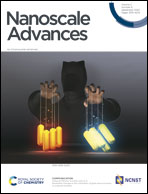Reversible changes in the orientation of gold nanorod arrays on polymer brushes†
Abstract
Nanoparticles exhibit a number of unique properties such as localized surface plasmon resonance (LSPR). As this LSPR is sensitive to geometrical or spatial conditions, the arrangement of nanoparticles, in particular the active arrangement of plasmonic structures, is an important issue. In this study, gold nanorod (GNR) arrays were prepared by GNR attachment on anionic polymer (DNA) brushes via electrostatic interactions and their stimuli-responsive changes in orientation were investigated. As a result, the orientation of GNR arrays on DNA brushes reversibly changed by the modulation of electrostatic interactions between GNRs and polymers via changes in the solution pH. As these extensive GNR arrays are prepared via easy bottom-up processes, GNR surface properties are easily tuned by simple modification, and DNAs could be replaced with various synthetic polymers, we believe that this study will lead to the development of next-generation materials and devices with actively tunable structures.



 Please wait while we load your content...
Please wait while we load your content...